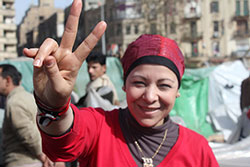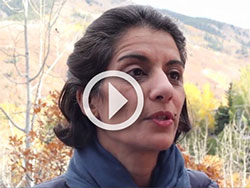
Despite dealing daily with what might seem like uphill battles, Sanam Anderlini remains emphatically positive that with hard work and resources peace is possible. We agree. So how do we get there?
Sanam Anderlini’s work continues to give vulnerable populations a voice, both locally and globally. Last week in Turkey, for instance, women at a forum hosted by ICAN, the organization Anderlini co-founded, called for the international community to uphold UN Security Council Resolution 1325 on women. They want to be joined in efforts to strengthen women’s voices, work with men to counter violence, and hold governments accountable. Despite dealing daily with what might seem like uphill battles, Ms. Anderlini remains emphatically positive that with hard work and resources peace is possible. We agree. So how do we get there?
Many fundamental questions need addressing in order to better understand the mix of institutions and beliefs most likely to support peace in the 21st century. In her interview above, Ms. Anderlini brings up two that speak to some core elements of research at the One Earth Future Foundation. The first is that we must fully come to terms with the idea that violence is a strategy, not an outcome. Some non-state groups (and some states for that matter) use violence to achieve some end. In and of itself, however, violence is not the end and this is important to understand.

Think about a construction project. If you need to connect boards you can use a number of methods: hammer and nail, screws, glue, gravity, etc… The tool you choose depends on a number of things such as your materials on hand, expectations about the end product, and experience. Violent tactics, like hammers, are a tool groups choose when they expect some utility from their application. If we can tweak institutions and beliefs in order to diminish the utility of violent options and increase that of nonviolent tools (e.g. political participation, nonviolent protest, or civic engagement), we will go a long way towards a world without war.
Moreover, once we fully conceptualize violence as a means and not an end, the set of relevant questions changes. Instead of combatting an enemy, let’s put questions about how we can change rebel tactics at the fore. For instance, what strategies can the international community pursue that would decrease the willingness of radical extremists to use violence? And, as Ms. Anderlini notes, how can the international community support institutions that ensure nonviolent voices have more profound influence?
A second point of intersection between Ms. Anderlini and research at OEF is the recognition that the players have changed and that we can learn a lot from other sectors. Reforming our security practices will take more than reforming our military to account for development and economic progress after a conflict. While we have begun to understand and categorize other non-state actors relevant to sustaining peace, we are not near a full accounting. Nor are we near an algorithm about how to conduct a full accounting. We know that non-state actors matter, perhaps now more than ever. But which ones and under what conditions?
 And, as we more fully come to terms with this new cast of characters, we will need to develop better models to learn from them. Ms. Anderlini mentions learning lessons from successful lobbyists as a means to better our communication strategies. Truth is, the NRA might actually have a lot to teach us about how to persuade key individuals to stand up for nonviolence and convince their supporters to do the same. To that end, a more practical assessment is necessary. While we might like to engage with like-minded actors, it probably makes sense for us to take a step back and ask who can teach us the most about consolidating winning strategies for nonviolent dispute resolution. In embracing these lessons, I agree with Ms. Anderlini that the possibilities are endless.
And, as we more fully come to terms with this new cast of characters, we will need to develop better models to learn from them. Ms. Anderlini mentions learning lessons from successful lobbyists as a means to better our communication strategies. Truth is, the NRA might actually have a lot to teach us about how to persuade key individuals to stand up for nonviolence and convince their supporters to do the same. To that end, a more practical assessment is necessary. While we might like to engage with like-minded actors, it probably makes sense for us to take a step back and ask who can teach us the most about consolidating winning strategies for nonviolent dispute resolution. In embracing these lessons, I agree with Ms. Anderlini that the possibilities are endless.
Article Details
Published
Written by
Topic
Program
Content Type
Opinion & Insights
